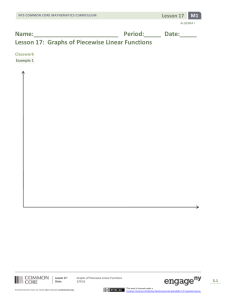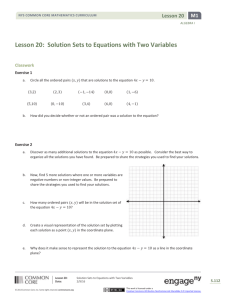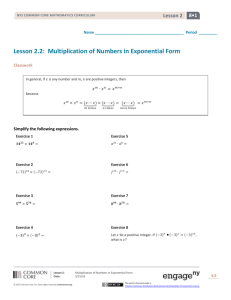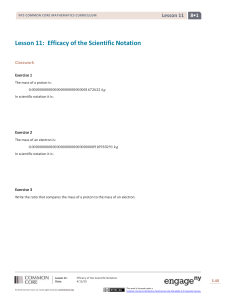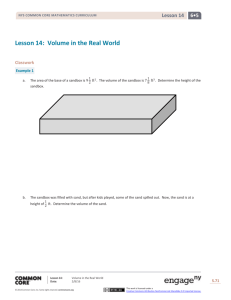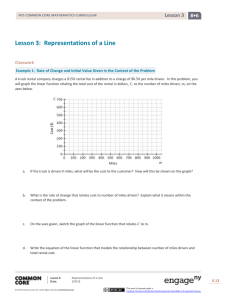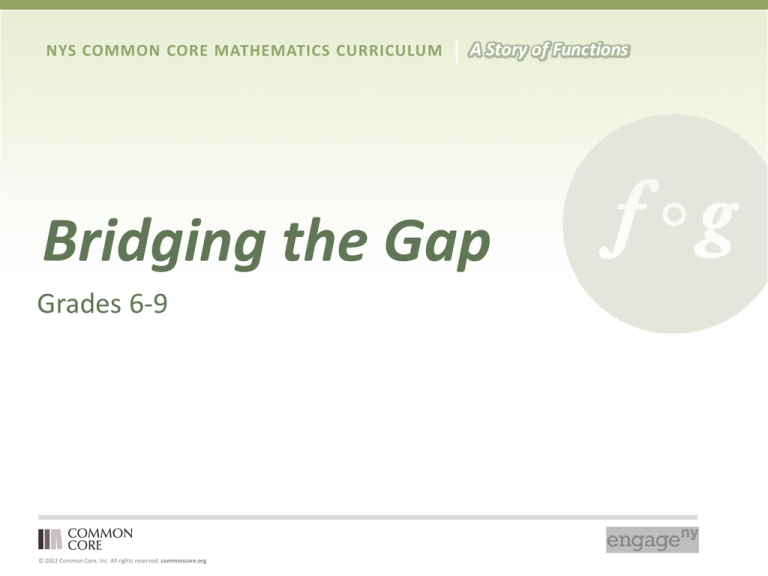
NYS COMMON CORE MATHEMATICS CURRICULUM
A Story of Functions
Bridging the Gap
Grades 6-9
© 2012 Common Core, Inc. All rights reserved. commoncore.org
NYS COMMON CORE MATHEMATICS CURRICULUM
A Story of Functions
Session Objectives
• Learn and experience efficient ways to assess and
remediate prerequisite knowledge:
•
•
•
•
Assessing Conceptual Understanding
Remediating Conceptual Understanding Gaps
Assessing Fluency
Remediating Fluency Gaps
© 2012 Common Core, Inc. All rights reserved. commoncore.org
NYS COMMON CORE MATHEMATICS CURRICULUM
A Story of Functions
Assessing Prerequisite Knowledge –
Conceptual Understanding
•
•
•
•
•
•
•
•
The 4 basic operations and their models
Properties of operations
The equal sign
The inequality signs
Fractions; operations with fractions; fractions as division
Operations with negative numbers
Exponentiation
Systems of Linear Equations
© 2012 Common Core, Inc. All rights reserved. commoncore.org
A Story of Functions
NYS COMMON CORE MATHEMATICS CURRICULUM
The 4 Basic Operations - Addition
Addition means putting together (like objects or like quantities)
Model 1: Part-part whole: finding the whole
Write me a word problem…
… in which you need to find
1
3
+
5
2
to solve the problem.
…in which you need to use the expression 𝑥 + 3 to solve
the problem.
…in which you need to use the expression 𝑥 + 𝑦 to solve
the problem.
© 2012 Common Core, Inc. All rights reserved. commoncore.org
NYS COMMON CORE MATHEMATICS CURRICULUM
Remediation Strategy
• Assess
• Discuss
• Repeat
© 2012 Common Core, Inc. All rights reserved. commoncore.org
A Story of Functions
NYS COMMON CORE MATHEMATICS CURRICULUM
A Story of Functions
The 4 Basic Operations - Addition
Addition means putting together
Model 2: Comparison Model, e.g. “3 more than”
• Give Joe 5 Starburst. Now give Max enough Starbursts so
that he has 3 more than Joe. How many does Max have?
• Give students 17 Starbursts and ask: show me how to
split up these Starbursts so that Max gets 3 more than Joe.
• If Max has 1.7 more feet of string than Joe and all
together they have 9.3 feet of string, how much string
does each boy have?
© 2012 Common Core, Inc. All rights reserved. commoncore.org
NYS COMMON CORE MATHEMATICS CURRICULUM
A Story of Functions
The 4 Basic Operations - Addition
Addition means putting together
Model 2: Comparison Model, e.g. “3 more than”
Max’s string
1.7 feet
9.3 feet
Joe’s string
2 units = 7.6 feet; 1 unit = 3.8 feet
• If Max has 1.7 more feet of string than Joe and all together they
have 9.3 feet of string, how much string does each boy have?
© 2012 Common Core, Inc. All rights reserved. commoncore.org
NYS COMMON CORE MATHEMATICS CURRICULUM
A Story of Functions
Remediation Strategy
• Assess
• Discuss and/or Model
(Concrete Pictorial Visualization)
• Repeat
© 2012 Common Core, Inc. All rights reserved. commoncore.org
NYS COMMON CORE MATHEMATICS CURRICULUM
A Story of Functions
The 4 Basic Operations - Subtraction
Subtraction means taking apart or taking away
Model 1: Part-part whole: finding one part
Write me a word problem…
…in which you need to find 12.12 – 3.5 to solve the
problem.
… in which you need to use the expression 𝑥 – 4 to solve
the problem.
… in which you need to use the expression 𝑥 – 𝑦 to solve
the problem.
© 2012 Common Core, Inc. All rights reserved. commoncore.org
NYS COMMON CORE MATHEMATICS CURRICULUM
A Story of Functions
The 4 Basic Operations - Subtraction
Subtraction means taking apart or taking away
Model 2: Comparison, e.g. “3 fewer than”
• Give Joe 12 Starburst. Now give Max enough Starbursts so
that he has 3 fewer than Joe. How many does Max have?
• Give students 17 Starbursts and ask: show me how to
split up these Starbursts so that Max gets 3 fewer than
Joe.
• If Max has 1.7 less feet of string than Joe and all together
they have 9.3 feet of string, how much string does each
boy have?
© 2012 Common Core, Inc. All rights reserved. commoncore.org
NYS COMMON CORE MATHEMATICS CURRICULUM
A Story of Functions
The 4 Basic Operations - Subtraction
Subtraction means taking apart or taking away
Model 2: Comparison, e.g. “3 fewer than”
Max’s string
1.7 feet
9.3 feet
Joe’s string
• If Max has 1.7 less feet of string than Joe and all together they
have 9.3 feet of string, how much string does each boy have?
© 2012 Common Core, Inc. All rights reserved. commoncore.org
NYS COMMON CORE MATHEMATICS CURRICULUM
A Story of Functions
The 4 Basic Operations – Multiplication
Multiplication means putting together equal groups
Model 1: Equal groups model
Write me a word problem…
…in which you need to find 12 • 3 to solve the problem.
…in which you need to use the expression 12𝑥 to solve the
problem.
… in which you need to use the expression 𝑥𝑦 to solve the
problem.
© 2012 Common Core, Inc. All rights reserved. commoncore.org
NYS COMMON CORE MATHEMATICS CURRICULUM
A Story of Functions
The 4 Basic Operations – Multiplication
Multiplication means putting together equal groups
Model 2: Array model
• Is it true that 5 • 3 will have the same value as 3 • 5? How
can I prove it will work for any two numbers I pick?
Why should it be obvious that the number of dots here:
Should be the same as the number here?
© 2012 Common Core, Inc. All rights reserved. commoncore.org
NYS COMMON CORE MATHEMATICS CURRICULUM
A Story of Functions
The 4 Basic Operations – Multiplication
Multiplication means putting together equal groups
Model 3: Area model
What does area mean?
How do I find it?
Write me a word problem where I am trying to find the
area of something.
© 2012 Common Core, Inc. All rights reserved. commoncore.org
NYS COMMON CORE MATHEMATICS CURRICULUM
A Story of Functions
The 4 Basic Operations – Multiplication
Multiplication means putting together equal groups
Model 4: Comparison model
Amy has 5 times as many Starbursts as Meg. They have
24 Starbursts all together. How many Starbursts does each
girl have?
Meg
24
Amy
6 units = 24; 1 unit = 4
© 2012 Common Core, Inc. All rights reserved. commoncore.org
NYS COMMON CORE MATHEMATICS CURRICULUM
A Story of Functions
The 4 Basic Operations – Division
Division means separating into equal groups
• Write me a word problem in which you need to find 12 ÷ 3
to solve the problem
• Write me a word problem in which you need to compute
1
12 ÷ to solve the problem.
2
Model 1: Finding the number in each group (knowing the
number of groups)
Model 2: Finding the number of groups (knowing the number in
each group)
© 2012 Common Core, Inc. All rights reserved. commoncore.org
NYS COMMON CORE MATHEMATICS CURRICULUM
A Story of Functions
The 4 Basic Operations – Division
Another approach to differentiating between first two models:
• Act out the process of the problem you wrote (for model 1).
Let’s compare that to my problem. Act out the process of the
problem I wrote. What do you notice?
• There are two ways to perform the division problem, 12 ÷3,
grabbing groups of 3 (repeated subtraction), vs. giving one to
each of 3 groups until there are none left.
• Write me a problem where you are asking to find the number
of groups (not the number in each group).
© 2012 Common Core, Inc. All rights reserved. commoncore.org
NYS COMMON CORE MATHEMATICS CURRICULUM
A Story of Functions
The 4 Basic Operations – Division
To reinforce the understanding of the “how
many groups” model, change our language:
12÷3
Instead of “Twelve divided by three”…
…“How many three’s are in twelve?”
How many one-halves are in 12?
© 2012 Common Core, Inc. All rights reserved. commoncore.org
NYS COMMON CORE MATHEMATICS CURRICULUM
A Story of Functions
The 4 Basic Operations – Division
Division means separating into equal groups
Model 3: Array model – Finding the number of rows given the
number of columns (or vice versa).
Model 4: Area model – Finding a missing side length, given the
area and a side length.
Write me a word problem about area of a rectangle in
which you need to find 12 ÷ 3 to solve the problem.
© 2012 Common Core, Inc. All rights reserved. commoncore.org
NYS COMMON CORE MATHEMATICS CURRICULUM
© 2012 Common Core, Inc. All rights reserved. commoncore.org
A Story of Functions
NYS COMMON CORE MATHEMATICS CURRICULUM
© 2012 Common Core, Inc. All rights reserved. commoncore.org
A Story of Functions
NYS COMMON CORE MATHEMATICS CURRICULUM
A Story of Functions
Equal and Inequality Signs
•
The equal sign
• What value would make this statement true?
• 11 – 5 =
+2
• The inequality signs
• Give me a value that would make this statement true:
•14 – 6 < + 3
© 2012 Common Core, Inc. All rights reserved. commoncore.org
NYS COMMON CORE MATHEMATICS CURRICULUM
A Story of Functions
Fractions
1
2
1
5
• What is + ?
• Write me a word problem that requires computing
in order to solve the problem.
© 2012 Common Core, Inc. All rights reserved. commoncore.org
1
2
1
−
3
NYS COMMON CORE MATHEMATICS CURRICULUM
A Story of Functions
Fractions
3
4
• What is of 60?
2
3
• Write me a word problem that requires finding ∙ 60 in
order to solve the problem.
© 2012 Common Core, Inc. All rights reserved. commoncore.org
NYS COMMON CORE MATHEMATICS CURRICULUM
A Story of Functions
Fractions
• What is 3 ÷ 5? (Write your answer as a fraction.)
• How many
1
’s
3
are in 5?
• Write me a word problem that requires finding 5
© 2012 Common Core, Inc. All rights reserved. commoncore.org
1
÷ .
3
NYS COMMON CORE MATHEMATICS CURRICULUM
A Story of Functions
Dividing a Fraction by a Fraction
• Write me a word problem where you have to
compute 2/3 ÷1/6.
• Precede this challenge with the development on the
next slide.
© 2012 Common Core, Inc. All rights reserved. commoncore.org
NYS COMMON CORE MATHEMATICS CURRICULUM
A Story of Functions
Dividing a Fraction by a Fraction
A Progression for students: Use tape diagram to demonstrate the
answer to the following:
• How many ½’s are in 6?
• How many 1/3’s are in 6?
• How many 1/3’s are in 1?
• How many 1/3’s are in 2/3?
• How many 1/3’s are in ½?
• How many 5/2’s are in 2/3?
© 2012 Common Core, Inc. All rights reserved. commoncore.org
NYS COMMON CORE MATHEMATICS CURRICULUM
Operations with Negatives
Why should 4 – (-3) = 7 be true?
Why is (5)(-3) negative?
Why is (-5)(3) negative?
Why should a negative x a negative = a positive?
© 2012 Common Core, Inc. All rights reserved. commoncore.org
A Story of Functions
NYS COMMON CORE MATHEMATICS CURRICULUM
A Story of Functions
Exponentiation
Make up a word problem…
… in which the expression 1.13 will be used in solving it.
… in which the expression 1.15 will be used in solving it.
… in which the expression 35 will be used in solving it.
© 2012 Common Core, Inc. All rights reserved. commoncore.org
NYS COMMON CORE MATHEMATICS CURRICULUM
Solving Systems of Equations
Consider the following question:
© 2012 Common Core, Inc. All rights reserved. commoncore.org
A Story of Functions
NYS COMMON CORE MATHEMATICS CURRICULUM
A Story of Functions
Solving Systems of Equations
Here is the solution according to the answer key for the test:
© 2012 Common Core, Inc. All rights reserved. commoncore.org
NYS COMMON CORE MATHEMATICS CURRICULUM
A Story of Functions
Solving Systems of Equations
A-REI.5
Prove that, given a system of two equations in two variables,
replacing one equation by the sum of that equation and a
multiple of the other produces a system with the same
solutions.
© 2012 Common Core, Inc. All rights reserved. commoncore.org
NYS COMMON CORE MATHEMATICS CURRICULUM
Solving Systems of Equations
Here is a graph of the two equations:
© 2012 Common Core, Inc. All rights reserved. commoncore.org
A Story of Functions
NYS COMMON CORE MATHEMATICS CURRICULUM
A Story of Functions
Correcting the Misconception
Sketch the graph of each equation in the following system:
3𝑥 − 𝑦 = −6
𝑥 + 2𝑦 = 5
Replace one equation with the sum of the first equation and the
second equation.
Sketch a graph of the new equation.
© 2012 Common Core, Inc. All rights reserved. commoncore.org
NYS COMMON CORE MATHEMATICS CURRICULUM
A Story of Functions
Correcting the Misconception
“The graph of the new equation will also pass through (or
contain) the intersection point (the solution point).
Suppose the new equation is 𝑥 = 3. The graph of that
equation passes through the solution point, therefore the
solution point must have an 𝑥-coordinate of 3.
This is helpful, let’s be strategic about how we replace one
equation with the sum of itself and a multiple of the other”
© 2012 Common Core, Inc. All rights reserved. commoncore.org
NYS COMMON CORE MATHEMATICS CURRICULUM
A Story of Functions
Remediating Prerequisite Knowledge
First address conceptual understanding:
• Conceptual Questioning / Discussion / Models
• 15 minute sessions or whole class sessions?
• All at the beginning of the year or throughout the year?
Then address fluency:
• Rapid White-Board Exchanges (first)
• Sprints (second, if feasible)
© 2012 Common Core, Inc. All rights reserved. commoncore.org
NYS COMMON CORE MATHEMATICS CURRICULUM
A Story of Functions
Fluency – Rapid White Board Exchanges
• Do 10-20 problems depending on how long each problem will
take.
• Fluency work should take from 5-12 minutes of class
• All students will need a personal white board, white board
marker, and a means of erasing their work.
• Prepare/post the questions in a way that allows you to reveal
them to the class one at a time.
© 2012 Common Core, Inc. All rights reserved. commoncore.org
NYS COMMON CORE MATHEMATICS CURRICULUM
A Story of Functions
Fluency – Rapid White Board Exchanges
2𝑥 + 3 = 5𝑥 − 9
2 𝑥+1 =3 𝑥−1
3 4𝑥 − 7 − 4𝑥 = −2 𝑥 + 3 − 10
© 2012 Common Core, Inc. All rights reserved. commoncore.org
NYS COMMON CORE MATHEMATICS CURRICULUM
A Story of Functions
Fluency – Rapid White Board Exchanges
• Reveal or say the first problem followed by “Go”.
• Students work the problem on their boards and hold their
work up for their teacher to see their answers as soon as they
have the answer ready.
• Give immediate feedback to each student, pointing and/or
making eye contact and affirm correct with, “Good job!”,
“Yes!”, or “Correct!”, or gentle guidance for incorrect work
such as “Look again,” “Try again,” “Check your work,” etc.
• If many students struggled, go through the solution of that
problem as a class before moving on to the next problem in
the sequence.
© 2012 Common Core, Inc. All rights reserved. commoncore.org
NYS COMMON CORE MATHEMATICS CURRICULUM
A Story of Functions
Fluency – Sprints
• Your class is ready for a sprint when students are able to make
it through a set of rapid white board exchanges in which every
student got some correct, and only one or two needed to be
done as a class.
• Sprints are done in pairs – both sprints have very similar
problems that progress from easy enough that all students will
get some correct in the first ¼ to hard enough that even the
best students are challenged in the last ¼.
• Typically 44 problems on a sprint. Always 60 seconds to
complete one sprint. Follow the guidance in How to
Implement A Story of Units and/or the 6-8 Fluencies
© 2012 Common Core, Inc. All rights reserved. commoncore.org


